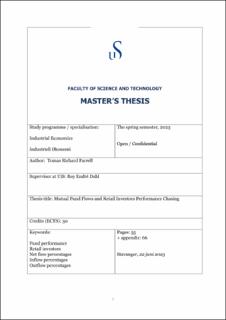| dc.description.abstract | This thesis analyses the impact of past performance on Norwegian retail investors capital allocation choices in actively managed equity mutual funds. The timeframe January 2001 to June 2022 is considered. Performance is measured as a fund’s relative rank against other funds on raw returns, and on the performance metrics Sharpe Ratio and Jensen’s alpha from the Fama-French three-factor model. The analysis is performed using a piecewise linear regression model based on the work of Sirri and Tufano (1998), which allows for a non-linear relationship between past performance and fund flows.
The initial analysis focuses on net flows, but these are subsequently disaggregated into its parts of inflow and outflow to evaluate the impact of each. The flow-performance relationship is further evaluated by separately evaluating mutual funds that invest in Norwegian equities, and those with global investment mandates. The January 2001 to June 2022 timeframe is also split into three periods to evaluate if the flow-performance relationships are consistent through time. Lastly, a performance evaluation of the in-sample funds is performed for a more thorough understanding of what exactly investors are reacting to when they allocate capital.
The fund analysis finds that, in aggregate, Norwegian funds that invest globally underperform their benchmarks. Mutual funds investing in Norway perform better than their indexes when considering both raw returns and Sharpe Ratio, but fail to do so in the Fama-French three-factor model.
The analysis of net flows finds that Norwegian retail investors allocate significantly more capital to the best performing mutual funds. This is true for funds focused on Norwegian equities, as well as for those focused globally. It has also been valid from January 2001 to February 2020, but has failed to materialize since COVID-19 started. The results show that performance chasing occurs throughout the performance range for mutual fund purchases, where funds are estimated to receive more inflow than the peers they outperform. The outflow results are less clear, and vary by performance metric. The most consistent result is that investors flee the absolute worst performing funds. | |
